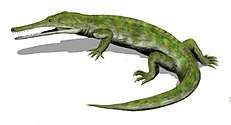Cteniogenys
Cteniogenys is a genus of choristodere, a morphologically diverse group of aquatic reptiles.
| Cteniogenys Temporal range: Late Jurassic | |
|---|---|
| Scientific classification | |
| Kingdom: | |
| Phylum: | |
| Class: | |
| Order: | |
| Family: | |
| Genus: | Cteniogenys Gilmore, 1928 |
| Species | |
| |
Distribution
Fossils of Cteniogenys are known from the Late Jurassic of Portugal, western Europe, and the Late Jurassic-age Morrison Formation of western North America.
A handful of skull and jaw fragments from the Late Cretaceous Oldman Formation and Dinosaur Park Formation in Canada were assigned to Cteniogenys by Gao and Fox (1998).[1] Given the long gap in time, however, Gao et al. (2005) cautioned that these remains could constitute a different, as-yet undetermined genus. In their description of new material of Khurendukhosaurus, Matsumoto et al. (2009) agreed that the putative Cretaceous occurrence of Cteniogenys did not belong to that genus and represents an indeterminate choristoderan.[2][3]
Systematics
The genus was named in 1928 by Charles W. Gilmore on the basis of a lower jaw collected during the late 19th century by Othniel Charles Marsh's workers at Como Bluff. He tentatively described the genus as a lizard, noting that it could instead be a frog.[4] New material of Cteniogenys from Europe prompted Susan E. Evans to reclassify it as an early choristodere in 1989.[5] To date it is only known from fragmentary specimens.[2]
Description
Cteniogenys was 25 to 50 centimetres (9.8 to 19.7 in) long, and probably weighed less than 500 grams (1.1 lb). The skull of this genus was long and slender, and the jaws had numerous conical teeth. Cteniogenys in the Morrison probably fed on insects and small fish. It is mostly known from freshwater sites (rivers and ponds), and is a rare find in the formation (only 60 specimens out of over 2,800 total vertebrate specimens known from the formation), mostly known from northern outcrops (particularly Wyoming); this may reflect a preservation bias against small animals in terrestrial settings, rather than an accurate reflection of Cteniogenys populations in the Morrison.[4]
See also
References
- Gao, K, and Fox, R.C., 1998. New choristoderes (Reptilia: Diapsida) from the Upper Cretaceous and Paleocene, Alberta and Saskatchewan, Canada, and phylogenetic relationships of the Choristodera. Zool J Linn Soc. 124:303–353.
- Gao, Keqin; Brinkman, Donald E. (2005). "Choristoderes from the Park and its vicinity". In Currie, Phillip J.; Koppelhus, Eva (eds.). Dinosaur Provincial Park: A Spectacular Ancient Ecosystem Revealed. Bloomington: Indiana University Press. pp. 221–234. ISBN 0-253-34595-2.
- Matsumoto, R, Suzuki, S, Tsogtbaatar, K, Evans, SE, 2009. New material of the enigmatic reptile Khurendukhosaurus (Diapsida: Choristodera) from Mongolia. Naturwissenschaften 96:233–242.
- Foster, John (2007). Jurassic West: The Dinosaurs of the Morrison Formation and Their World. Bloomington, Indiana: Indiana University Press. pp. 146–148. ISBN 978-0-253-34870-8. OCLC 77830875.
- Evans, Susan E. (1989). "New material of Cteniogenys (Reptilia: Diapsida) and a reassessment of the phylogenetic position of the genus". Neues Jahrbuch für Geologie und Paläontologie, Monatshefte. 1989 (10): 577–589.

